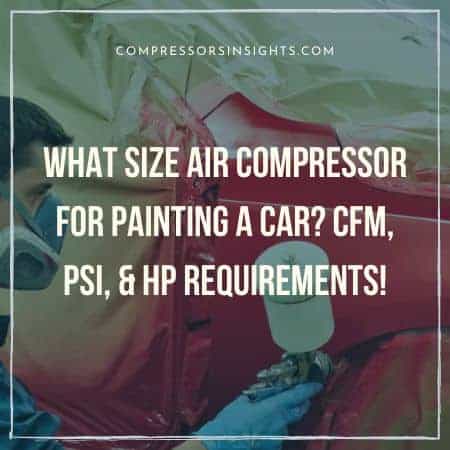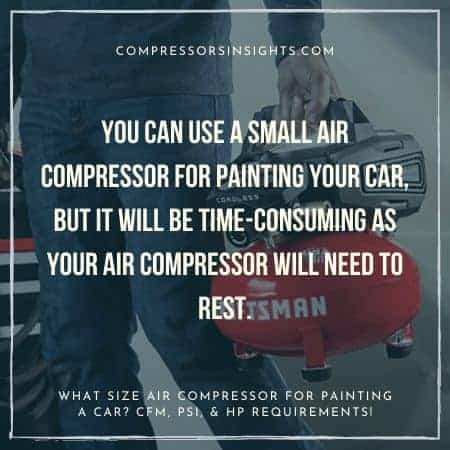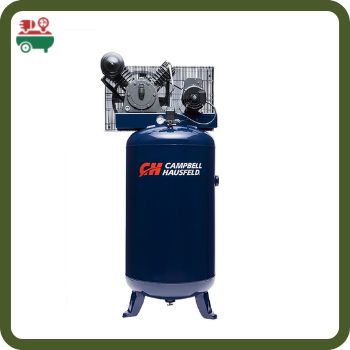What Size Air Compressor For Painting a Car? 5 Crucial Factors to Consider!
TheToolGeeks.com is a participant in the Amazon Services LLC Associates Program and other affiliate advertising programs. We may earn from qualifying purchases. (Learn More).
When we use a paint gun with an air compressor, it saves our time and makes the task easier and more efficient. But, getting an air compressor according to your paint gun and your requirements sometimes can be daunting. Why? Because there are multiple applications associated with a paint gun, and the primary application is painting a car.
But, what size air compressor for painting a car will be a good choice?
You should consider certain factors while getting the right size air compressor for automotive painting, such as CFM, Paint Gun Type (HVLP & LVLP), PSI, and Tank size.
Without further ado, let’s dive in to know how you can select a suitable size of air compressor if you’re going to deal with auto painting.

What Size Air Compressor for Painting a Car? (5 Things to Consider)
1. Paint Gun
A paint gun is a tool that is used for painting multiple objects. According to its capacities, you can even paint a car or van. The great advantage of using a paint sprayer is that: it gives a finishing touch, and it’s faster than brushes or rollers. It uses compressed air from the nozzle to spray the paint, and it works by applying force on it, causing it to spread in particles.
What are HVLP and LVLP Paint Guns?
HVLP Spray Guns
When you have to paint a car, an HVLP spray gun plays an ideal role. It gives finishing and smoothness, and it reduces time and over-spraying.
LVLP Spray Guns
If you want to do the task quickly and save money, this works on low air consumption and less strength. It uses 5-18 CFM, 10-25 CFM & 20-30 PSI, 30– PSI. It is a combination of HVLP and conventional air spray.
2. Tank Size
The tank size of the compressor should be adequate. As a result, you will be able to continue working continuously without running out of air. The tank size of around 60-80 Gallon is ideal for painting an entire car. The small air compressor tank can also do a painting of a car, but it will be time-consuming.
3. CFM
To paint a car, you need an air compressor with a large air tank and a CFM of at least 12-15. CFM is like a primary factor of the compressor. To handle the paint gun, it needs a higher CFM. If your paint gun is 12 CFM, you must have a compressor of around 15 CFM.
4. Horsepower
Horsepower determines how powerful an air compressor is. The large air tank of 60-gallon with a horsepower of 5-10 will be ideal for painting a car, and it is suitable for providing power to heavy tools.
5. Air Pressure
Paint guns should have an air pressure of 20-25 PSI. The brush strokes, touch-ups, and shading need it. But they are also soft coverages. To do more and seal top coating type applications, you may need 40-45 PSI.
Reciprocating or Rotary Air Compressors – Which One is Good for Painting a Car?
Rotating screw compressors are less maintenance-intensive, highly efficient, and may not have the same CFM capacity as reciprocating compressors, but they are still ideal for painting.
In addition to it, they do not produce a lot of heat and can cool themselves with less HP. The reciprocating air compressor needs regular maintenance, oil, and check valves and pistons. It is common to use a rotary screw compressor to paint a car since it is effective, efficient and does not make noise.
Portable or Stationary – Which One is Good for Painting a Car?
Both Portable and stationary air compressors can be used to paint a car. However, a portable device allows you to use it for other purposes and move around quickly. The wheel’s compressor is much handier than the stationary one.
The size of the compressor you must look for other than tank size, CFM, and PSI as they are the primary factors.
Guide to Pair Up a Car Spray Gun with an Air Compressor
Below are some of the steps that ones should follow to pair up a paint sprayer gun with an air compressor:
- You need to attach your hose to an air pot.
- You can install it using thread tape.
- Adjust the regulator at the required pressure.
- Set it on around 40-60 PSI.
- Always use a respiratory filter or goggles before using the spray gun.
- Apply the paint in an even motion.
- You can adjust the cap horizontally or vertically.
- Maintain the distance, and keep the spray gun moving.
Can I Use a Small Tank Air Compressor for Painting Cars?
Yes, you can use a small air compressor for painting your car, but it will be time-consuming as your air compressor will need to rest. The continuous use of the compressor can make it overheated, which can lead to dangerous results. A large compressor is required to paint a car, as it will save time, handle the heavy tools, and have a high CFM.

How to Paint a Car With an Air Compressor?
- You can paint your car with an air compressor in these easy steps:
- Cover the mirrors and headlights of the vehicle. (basically everything you do not want to paint).
- After carefully mixing your paint, clean any rusted areas of the car with the help of sandpaper.
- Maintaining a 15cm distance, now you can turn on the air compressor and start painting, either vertically or horizontally.
- You may need 2-3 coats to make the paint even on the car. (move your spray gun evenly).
Best Air Compressor for Spray Painting a Car
Campbell Hausfeld HS5180 Air Compressor – Best for LVLP

The Campbell air compressor is another large air compressor suitable for painting cars for many reasons. The 80-Gallon air compressor can perform in shops, automatic or DIY users.
The compressor can efficiently work on 230-V with heavy works like sanding, spraying, cutting metal, and grinding.
More than 20 high-demand air tools can effectively work with it. It is a heavy-duty compressor, which is oil lubricated. The vertical design of the compressor saves a lot of space in shops and works on 14 CFM at 90 PSI. The compressor has 12000 hours of work life.
Specification:
- The compressor has an 80-gallon air tank.
- It works on 230V
- The compressor is oil-lubricated and has cast iron and a two-stage pump.
- The compressor has 12,000 hours of work life.
- It has 14 CFM at 90 PSI with 175 PSI max.
- It works on 22 Amps, 1-PH, and 60-Hz.
It is ideal for heavy-duty work. The compressor is loud.
It is not ideal for indoors or quiet places.
Conclusion
Using a paint gun with a compressor for painting a car is an effective and time-saving tool. However, you need to know what size air compressor for painting a vehicle is suitable? Large compressors with 60-80 gallon tanks, 12-15 CFM, and 5-10 HP will be the best choice.
You can also use a mini air compressor for car painting. But the burden can damage the compressor. It is recommended to use a mini compressor with 15 CFM of the compressor and 10 CFM of paint gun is ideal.
FAQ’s
Can you paint a car with a 30-gallon air compressor?
Painting a car with a 30-gallon air compressor will only be possible if you match your compressor CFM rating with the CFM of the paint gun. It will be the only option to paint your car with a 30-gallon air compressor.
Can you paint a car with a 10-gallon compressor?
You cannot do it in one shot if you want to paint your car with a 10-gallon compressor. Your compressor will run out of air, and it is impossible to paint the whole car in one sitting with the tank size of a 10-gallon air compressor. It causes pressure on your compressor, causing it to get heated.
Can you paint a car with a 26-gallon air compressor?
A 26-gallon air tank is relatively insufficient for painting the whole car. Your compressor will get empty in no time, and you will have to wait again to get it going. One single coating of a car might be possible if you know how to paint. Otherwise, it is a small compressor for painting a car.
Can I paint a car without an air compressor?
Without a compressor, painting a car will be difficult, but you can use a handheld airless paint sprayer to get the job done. It is ideal for spraying thick or thin materials, or you can use a brush or rollers, but it will be time-consuming.
Amazon and the Amazon logo are trademarks of Amazon.com, Inc, or its affiliates.
